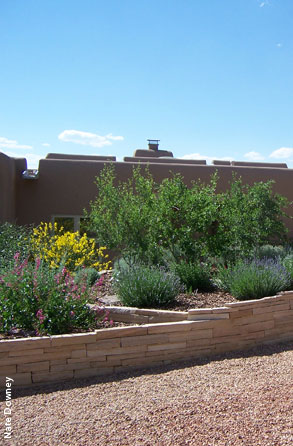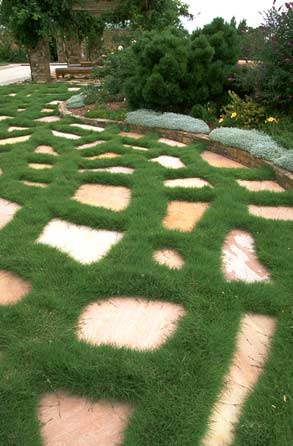“Practical Permaculture” is a column written by Santa Fe Permaculture’s founder and President, Nate Downey. It appears in “The Santa Fe New Mexican’s” monthly Real Estate Guide.
Water Harvesting
This season certainly has been beautiful. It’s been warm. It’s been clear. Except for some unseasonably persistent winds, we’ve enjoyed an extremely pleasant winter here on our high desert plateau. Of course, “nice” weather is really a matter of perspective.
If, to your plants, you could somehow express your enthusiasm for the all the recent sunshine, you would probably get a response similar to one that someone in the ski business might give you. “Like Hell!” he’d say, “Snow and cold weather are essential elements of my survival, and, when the wind blows whatever moisture we do have off the ground, it makes matters worse!” For skiers, there’s always next season. For plant lovers, such a winter of discontent could mean garden gloom.
Fortunately some simple water harvesting components can be added to the landscape in order to reduce the potentially devastating effects of a warm, dry, windy winter. The most important of these components is mulch. Mulch is defined as any material that blankets the earth and helps retain moisture in the soil. Bark, straw, compost and even gravel are good mulching materials. Any flora planted in the desert will be much more healthy if it is mulched — not only because of the moisture that mulches retain, but also because mulches moderate temperature changes, prevent soil erosion and often add essential nutrients to the soil. Mulches are also inexpensive and easy to put down either in simple rings around the root zones of your plants or across a denuded landscape. If cardboard, manure and straw are put down (in this order) these elements form a “sheet mulch”, which is not only effective as a weed barrier, but also creates a perfect microclimate for worms, fungi and other soil conditioners that live under the shade of a thick mulch.
Another important component of effective water harvesting is the “on-contour swale”. Such a swale is a simple ditch dug perpendicular to the direction of rainwater run-off with the dirt from the ditch placed and tamped on the downhill side in the form of a berm. Due to the extra moisture that inevitably accumulates under an on-contour swale, microclimates that resemble “mini-oases” can be created. If properly installed, swales not only will harvest the sheet flow associated with monsoonal rains, but they will also capture essential snowmelt.
Pumice wicks, or, at the very least French drains, are also important components of any effective water harvesting system — especially if such a system includes a building, a road or any impervious surface (even hard pan clay). Water from these surfaces can be directed into trenches of even holes filled with gravel or pumice that not only prevent localized erosion, but also create miniature underground reservoirs. When perennials are planted next to these reservoirs their chances of survival are significantly increased.
Cisterns are the most well known component of water harvesting, but they are usually more expensive than any of the systems discussed above — not only because appropriate storage tanks are themselves expensive, but also because cisterns usually require an electric pump and an irrigation system. However, cisterns are extremely effective, because the water they store can be used throughout an extended period of drought. Keep in mind that, when harvesting water during the winter, cisterns can freeze if they are not buried underground or painted black and exposed to plenty of direct sunlight. Above are five of the best ways to harvest the water resources that are freely (although infrequently) available from the desert sky.
With water rights as expensive as they are, with many municipal supplies as restricted as they are, if we do not start to install these systems voluntarily, one day we may be forced to install them as underground supplies are pumped primarily for drinking. As stewards of the desert landscape, it seems our responsibility to implement these techniques.
Published: March, 1999 | Copyright © 1999, Nate Downey.




